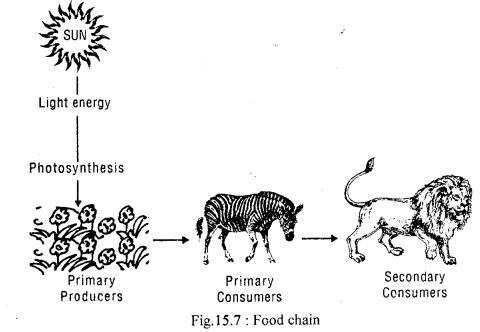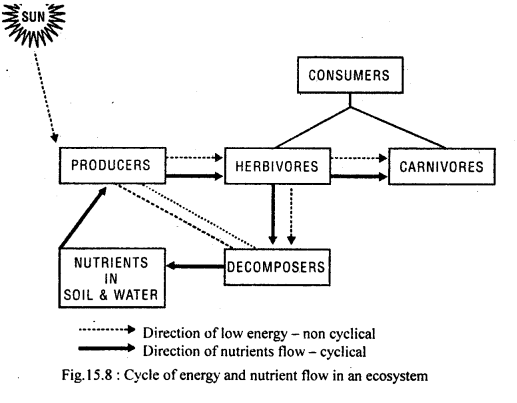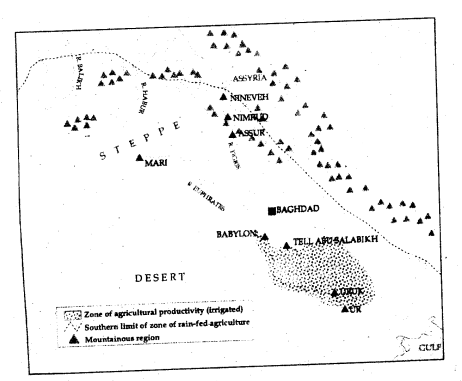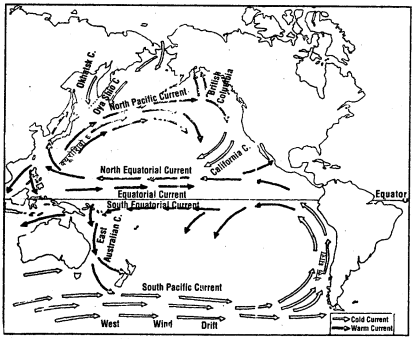Here we are providing Class 11 Geography Important Extra Questions and Answers Chapter 3 Drainage System. Important Questions for Class 11 Geography are the best resource for students which helps in class 11 board exams.
Important Questions for Class 11 Geography Chapter 3 Drainage System
Drainage System Important Extra Questions Very Short Answer Type
Question 1.
What is drainage?
Answer:
The flow of water through well-defined channels is known as drainage.
Question 2.
Where is the dendritic drainage pattern found in India?
Answer:
In Great plains of North India.
Question 3.
Give the name of two rivers of Central India.
Answer:
Godavari and Krishna.
Question 4.
Name the three rivers that flow into the Arabian Sea.
Answer:
Narmada, Tapi and Mahi.
Question 5.
What type of drainage pattern is found in the Thar desert?
Answer:
In Thar desert centripetal drainage pattern is found.
Question 6.
Give two examples of antecedent rivers.
Answer:
Brahmaputra and Kosi are the two antecedent rivers.
Question 7.
What do you mean by water regime?
Answer:
The seasonal flow of water in a river is called its water regime.
Question 8.
Name two rivers of Central India.
Answer:
Sind and Chambal.
Question 9.
When do peninsular rivers have maximum flow?
Answer:
The peninsular rivers have maximum flow in the rainy season.
Question 10.
Name the main watershed of peninsular rivers.
Answer:
The Western Ghats.
Question 11.
Name the two west-flowing rivers Qf peninsular India.
Answer:
Narmada and Tapi are the west-flowing rivers.
Question 12.
Which river falls into the Gulf of Khambat?
Answer:
Mahi river falls into the Gulf of Khambat.
Question 13.
Name the three types of Himalayan river systems.
Answer:
- The Indus system,
- The Ganga system,
- The Brahmaputra system.
Question 14.
What is a river basin?
Answer:
The watersheds of large rivers are called river basins.
Question 15.
Name the two sections of the western coastal plain.
Answer:
Konkan coast and Malabar coast are the two sections of the western coastal plain.
Question 16.
What is cuspate deltas?
Answer:
The rivers like Ebro of Spain which form the tooth-like delta at their mouth is known as cuspate delta.
Question 17.
What is a radial pattern of drainage?
Answer:
When the river radiates from a hill, the pattern is called radial.
Question 18.
Why the Himalayan rivers are perennial?
Answer:
Because the Himalayan rivers rise from glaciers.
Question 19.
Why the rivers meander and change their courses?
Answer:
Variable nature of the terrain and geological conditions cause the rivers to meander and change their courses.
Question 20.
Name the five main tributaries of the Indus river.
Answer:
The Chenab, the Ravi, the Beas, the Satluj and the Jhelum.
Question 21.
What do you mean by ‘punched’?
Answer:
‘Punched’ is the name given to the rivers of Punjab – the Satluj, the Beas, the Ravi, the Chenab and the Jhelum.
Question 22.
Name two streams which form the Chenab river.
Answer:
Chandra and Bhaga.
Question 23.
Which states are drained by the river Ganga?
Answer:
Uttranchal, Uttar Pradesh, Bihar and West Bengal are drained by the river Ganga.
Question 24.
Name the main river basins of the peninsula.
Answer:
Mahanadi, Godavari, Krishna and Kaveri are the four main basins of the peninsula.
Question 25.
Give the three important utilities of the Indian rivers.
Answer:
- Irrigation,
- Navigation, and
- Water power generation.
Drainage System Important Extra Questions Short Answer Type
Question 1.
Define a drainage system.
Answer:
The flow of water through well-defined channels is known as drainage. The network of such channels is called a drainage system. The drainage system includes the area drained by the river and its tributaries. The drainage pattern is of various types. The drainage pattern of an area is the product of the natural drainage pattern.
Question 2.
What are the various types of drainage patterns?
Answer:
The drainage pattern is of various types:
- Dendritic-When the drainage develops similar to branches of a tree.
- Radial – When the rivers radiate from a hill.
- Centripetal – When the rivers flow into a lake or a depression
- Trellis – When primary tributaries flow more or less parallel to one another and the secondary tributaries join from sides more or less a right angle.
Question 3.
Classify the Indian drainage on the basis of discharge of water,
Answer:
It may be classified into:
- The Arabian Sea drainage,
- Bay of Bengal drainage.
These two groups are separated from each other through the Delhi Ridge, the Aravallis, the Sahyadri and Amarkantak known as water divide.
Question 4.
What are the river basin and watershed?
Answer:
A river basin is a form of natural or artificial depression. The total area of the land drained by a river and its tributaries is known as a river basin. On the other hand, watershed means water-parting. Watershed may or may not be sharply defined, separating two continuous drainage areas from the head-stream flow in different directions into different river systems or river basins.
Question 5.
Give some characteristic features of the Kaveri basin.
Answer:
The Kaveri rises in Brahamgiri hills of Coorg district in Karnataka. It is 800 km. long and drains an area of67900 km2. The river carries water throughout the year with comparatively less fluctuation than other peninsular rivers.
Question 6.
Why flood is a frequent feature in the Brahmaputra basin?
Answer:
The Brahmaputra is one of the largest rivers in the world. It is a trans-Himalayan river. It rises in Kailash range near Mansarovar lake. It flows eastward longitudinally covering a distance of 1200 km. It forms a gorge in Namcha Barwa mountains. In India, it enters forming a gorge. It receives Dihang and Lohitas its tributaries. The characteristic feature of Brahmaputra is its flood. It is due to the fact that both the Purvanchal Himalayas and the Shillong plateau receive heavy rainfall.
Question 7.
Why do the rivers on the western coast have no deltas?
Answer:
The rivers over the western coast transport lot of sediment with them but do not form a delta, because they are unable to deposit this sediment at the coast. They are very swift due to the deep slope of the ghats and narrow coastal plain. Therefore they do not form deltas.
Question 8.
What is the difference between delta and estuary?
Answer:
| Dendritic | Trellis |
| In the dendritic pattern, the drainage develops similar to the branches of a tree. | In this pattern, the primary tributaries flow more or less parallel to one another and secondary tributaries join from the side. |
Question 9.
What are the east-flowing rivers?
Answer:
The Mahanadi, Godavari, Krishna and Kaveri are east-flowing rivers. These rivers are generally large and form huge deltas near their mouths. These rivers discharge themselves into the Bay of Bengal. These rivers do not flow through troughs.
Question 10.
What do you mean by cusecs and comes?
Answer:
The discharge of the volume of water flowing in the river is measured overtimes. It is measured either in cusecs or incomes. When the water is measured in cubic feet per second it is called cusecs. On the other hand, when the flowing water is measured in cubic metre per second it is called comes.
Question 11.
What are the characteristic features of west-flowing rivers?
Answer:
The Narmada and Tapi are the west-flowing rivers.
- These rivers do not form deltas.
- They flow westward on the peninsular plateau, are small but known as rivers.
- Narmada and Tapi flowthrough troughs which have been formed due to faulting.
- These rivers discharge themselves into the Arabian Sea.
Question 12.
What do you mean by consequent rivers?
Answer:
The Indus, Satluj, Kosi are the trans-Himalayan rivers. These rivers are known as consequent rivers. These rivers maintain their originals shape, deposit. The rise of the land due to folding rivers keep on flowing in the original direction. These rivers are older than the fold mountains. Rivers cut deep gorges due to down-cutting.
Drainage System Important Extra Questions Long Answer Type
Question 1.
Why do the rivers on the western coast have no deltas, even though they transport a lot of sediment with them? State three main characteristics of Himalayan and peninsular rivers.
Answer:
The rivers over the western coast transport lot of sediment with them but do not form a delta, because they are unable to deposit this sediment at the coast. They are very swift due to the deep slope of the ghats and narrow coastal plain. Therefore they do not form deltas.
Characteristics of Himalayan rivers – The characteristics of the Himalayan rivers are:
- The Himalayan river system consists of some longest rivers.
- The catchment areas and river basins of Himalayan rivers are large.
- These rivers originate from the snow-covered areas and receive water from rainfall as well as from snowmelt. They are periodic.
- These rivers are useful for irrigation and navigation.
Question 2.
Differentiate between Himalayan rivers and the Peninsular rivers.
Answer:
| The Himalayan Rivers | the Peninsular rivers |
| (1) The catchment area of the Himalayan river system is very large spreading over hundreds of square metres. | (1) The peninsular rivers have catchment area comparative to the Himalayan rivers. |
| (2) The Himalayan rivers flow into deep gorges in the mountainous regions and show meandering. These rivers have the intensive erosional capacity and carry huge loads of silt and sands annually. | (2) Peninsular rivers have the erosional capacity and flow in large graded slow valleys. These rivers flow over hard rock beds and show very little meandering. |
| (3) These rivers are perennial because they derive their water from snow and rainfall. The Himalayan rivers consist of three systems. The Indus system rivers flow towards the south-west and drain into the Arabian Sea. The rivers of Ganga and Brahmaputra systems flow eastward into drain into the Bay of Bengal. They form deltas. | (3) These rivers are seasonal. They are rainfed. They flow eastward on the plateau and drain into the Bay of Bengal. Narmada and Tapi are west-flowing rivers which flow into rift valleys. |
Question 3.
Write a short note on Balanced water on the Ganga basin.
Answer:
Ganga is the most important river of the northern plain, from both the point of view of its basin and cultural significance. It rises in the Gangotri glacier nearGomukh in Uttarkashi district of Uttranchal. Here it is known as Bhagirathi. At Dev Prayag, the Bhagirathi meets the Alaknanda and it is named as Ganga. Ganga enters the plains at Haridwar and flows southwards and south-east splitting into two distributaries namely Bhagirathi and the Hugh: The river is 2,525 km in length. The Ganga basin covers about 9,52,000 km2 in India alone.
Question 4.
Describe the formation of meanders.
Answer:
A river in its flood plain develops loops in its course and shows characteristic features. When water flows under gravity, it seldom flows straight for any long-distance and a winding course develops. The irregularities of the ground force the river to swing in loops. These loops are known as meanders. The ‘meander’ is a term derived from the winding river.
Thus meander is t. loop-like structure or curves in the river course. It is developed by lateral erosion.
Question 5.
The Indian rivers are useful for the country. Comment on the statement.
Answer:
A large number of rivers carry the rainwater of India into the sea. The total volume of annual precipitation in our country is approximately 37,00,400 million cubic metres. Out of this 45% flows through 113 rivers. However, for uneven topography and flow characteristics, all of this is not usable. 33% of the water from the annual flow is used for irrigation.
Large rivers have great water potential. 60% of the total river flow is concentrated in the Himalayas, 16% in the central Indian rivers (the Narmada, Tapi and Mahanadi). The country has an exploitable power potential of about 41 million km.
The Ganga and Brahmaputra in the north and north-eastern part, Mahanadi in Orissa, Krishna in Andhra, Narmada and Tapi in Gujarat possess some of the important and useful waterways in the country. The most important navigation rivers are the Ganga, the Brahmaputra and the Mahanadi. The Godavari, the Krishna, the Narmada and Tapi are navigable near their mouths only.
Thus, the major usability of Indian rivers is for irrigation, power generation and navigation. Besides, the rivers also supply water to cities, villages and industrial installations.






